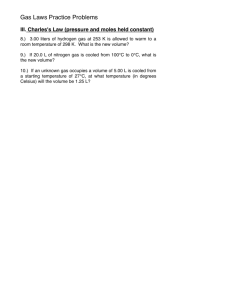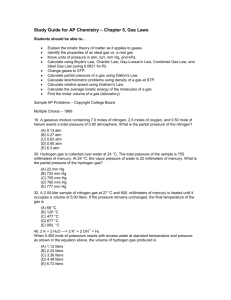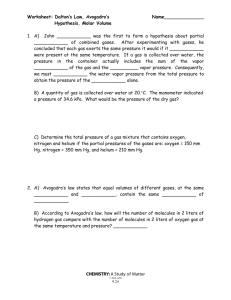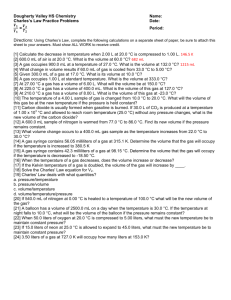Definitions and concepts directly associated with MC questions
advertisement
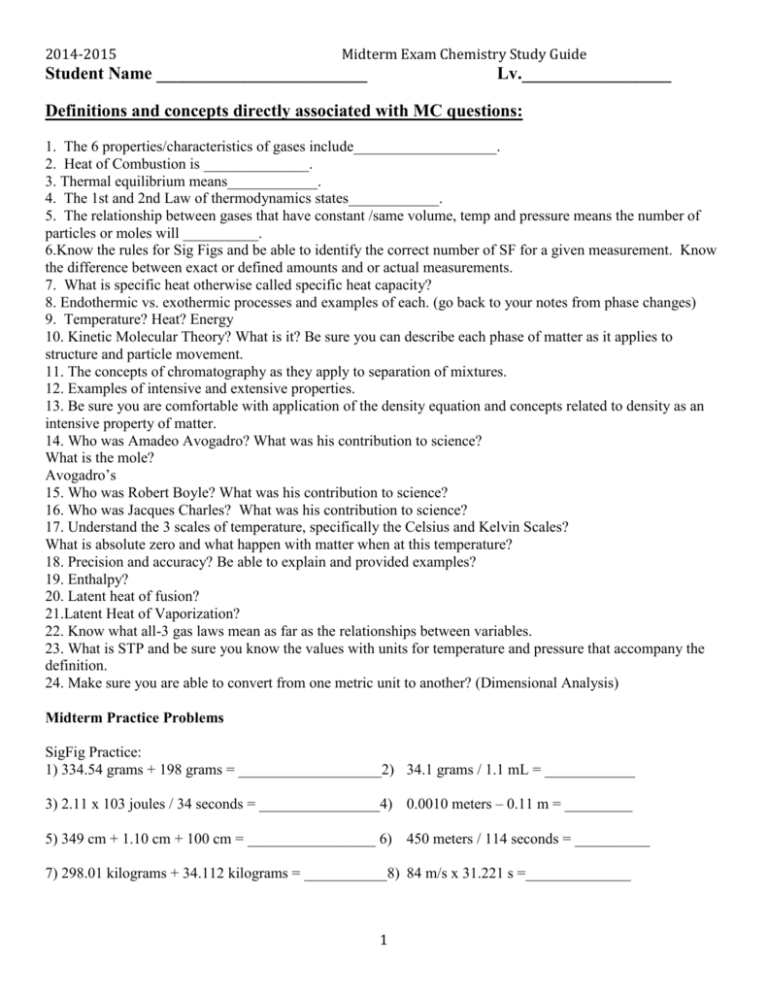
2014-2015 Midterm Exam Chemistry Study Guide Student Name ________________________ Lv._________________ Definitions and concepts directly associated with MC questions: 1. The 6 properties/characteristics of gases include___________________. 2. Heat of Combustion is ______________. 3. Thermal equilibrium means____________. 4. The 1st and 2nd Law of thermodynamics states____________. 5. The relationship between gases that have constant /same volume, temp and pressure means the number of particles or moles will __________. 6.Know the rules for Sig Figs and be able to identify the correct number of SF for a given measurement. Know the difference between exact or defined amounts and or actual measurements. 7. What is specific heat otherwise called specific heat capacity? 8. Endothermic vs. exothermic processes and examples of each. (go back to your notes from phase changes) 9. Temperature? Heat? Energy 10. Kinetic Molecular Theory? What is it? Be sure you can describe each phase of matter as it applies to structure and particle movement. 11. The concepts of chromatography as they apply to separation of mixtures. 12. Examples of intensive and extensive properties. 13. Be sure you are comfortable with application of the density equation and concepts related to density as an intensive property of matter. 14. Who was Amadeo Avogadro? What was his contribution to science? What is the mole? Avogadro’s 15. Who was Robert Boyle? What was his contribution to science? 16. Who was Jacques Charles? What was his contribution to science? 17. Understand the 3 scales of temperature, specifically the Celsius and Kelvin Scales? What is absolute zero and what happen with matter when at this temperature? 18. Precision and accuracy? Be able to explain and provided examples? 19. Enthalpy? 20. Latent heat of fusion? 21.Latent Heat of Vaporization? 22. Know what all-3 gas laws mean as far as the relationships between variables. 23. What is STP and be sure you know the values with units for temperature and pressure that accompany the definition. 24. Make sure you are able to convert from one metric unit to another? (Dimensional Analysis) Midterm Practice Problems SigFig Practice: 1) 334.54 grams + 198 grams = ___________________2) 34.1 grams / 1.1 mL = ____________ 3) 2.11 x 103 joules / 34 seconds = ________________4) 0.0010 meters – 0.11 m = _________ 5) 349 cm + 1.10 cm + 100 cm = _________________ 6) 450 meters / 114 seconds = __________ 7) 298.01 kilograms + 34.112 kilograms = ___________8) 84 m/s x 31.221 s =______________ 1 2014-2015 Midterm Exam Chemistry Study Guide Percent Error and Density: (The test will have all equations) 1. A student measured the temperature of boiling water and got an experimental value of 97.5C. What is the % error? 2. The mass of a certain chemical was determined by a very precise balance to be 1.4200 g. The same mass of a chemical was measured on a less precise balance and found to be 1.43 g. What is the percent error for the less precise balance? 3. Willomina Witty was assigned to determine the density of a sample of nickel metal. When she finished, she reported the density of nickel as 5.59 g/ml. However, Miraculous knew the density of nickel was 6.44 g/ml. 4. (+) A positive percent error indicates your experimental values are ______________ than the theoretical values. (-) A negative percent error indicates your experimental values are ______________ than the theoretical values. 5. Determine the percentage error in the following problems. Show all your work! Experimental Value: 1.24 g Theoretical Value: 1.30 g Temperature Conversion. Be sure to use the correct number of Sig Figs! TK= C + 273 TC = TK – 273 TF = 1.8 (C) +32 TC = F - 32/1.8 A) 26.3 C = _________ K B) 82.0 F = __________ K C) 273.14 K = ___________________ F D) 32.0F = ___________K Heating Curve/Freezing/Boiling Point Graph as well as Triple Point Graph 1. 2. 3. 4. 5. Label a,b,c,d,e solid, liquid, gas. Where is the phase change occurring? What is the process at point d and b? Where is energy absorbed and released? Where is condensation happening? 2 2014-2015 Midterm Exam Chemistry Study Guide Energy and Specific Heat & Heat of Combustion: 1. A 30.0 g (m) piece of glass at 30.0°C (Ti) is heated to 70.0 C (Tf) If the specific heat capacity is 0.70 J/g°C? (s) How much energy is absorbed (Q)? Q = smΔt 2. 15.0 g (m) of Mg is heated from 15.0°C to 105°C, and absorbs 400 joules (Q) of heat in the process. Calculate the specific heat capacity of mercury. S = Q/mΔT What is the 1st Law of thermodynamics? Be sure to include or be able to provide an example. What is the 2nd Law of thermodynamics? Be sure to include or be able to provide an example. Heat of Combustion: Here are some helpful reminders... Specific Heat of water = 4.184 J/(g·°C) = 1 cal/(g·°C). The density of water = 1 g/mL 1. Taking heat away from water makes ice cubes. Suppose you put 500.0 g of 20.0°C water in an ice tray and put it into the freezer. How many Joules of heat must be removed to cool the water to 0.0°C? 2. A sample of mercury metal is heated from 25.5° C to 52.5° C. In the process, 187 cal of heat are absorbed. What mass of mercury was in the sample? The specific heat of mercury is 0.033 cal/(g·°C) 3. A 0.1946 g piece of magnesium metal is burned in a constant-volume calorimeter. The calorimeter contains 500.0 g of water and the temperature rise is 1.40°C. 4. How much heat (in J) was given off during combustion of the sample of magnesium? 5. How much heat in kilojoules (kJ) was given off during combustion of the sample of magnesium? 6. What is the heat of combustion, in kilojoules per gram (kJ/g) of magnesium? Separation of Mixtures: Chromatography Color Dc Dw Red 1.89 cm 7.34 cm Violet 3.35 cm 7.34 cm Green 6.27 cm 7.34 cm Retention Factor Gas Laws (the exam will clearly indicate which equation to use for each answer. However, you are challenged her to determine this with the help of your notes.) Boyle’s Law: P1V1= P2V2 Charles Law: V1T2=V2T1 Ideal Gas Law: PV = nRT R = 0.0821 L*atm K*mol 1. A gas occupies 900.0 mL at a temperature of 27.0 °C. What is the volume at 132.0 °C? 2. If 15.0 liters of neon at 25.0 °C is allowed to expand to 45.0 liters, what must the new temperature be to maintain constant pressure? 3 2014-2015 Midterm Exam Chemistry Study Guide 3. A gas with a volume of 4.0L at a pressure of 205kPa is allowed to expand to a volume of 12.0L. What is the pressure in the container if the temperature remains constant? 4. What pressure is required to compress 196.0 liters of air at 1.00 atmosphere into a cylinder whose volume is 26.0 liters? 5. A 40.0 L tank of ammonia has a pressure of 12.7 kPa. Calculate the volume of the ammonia if its pressure is changed to 8.4 kPa while its temperature remains constant. 6. If I have 4 moles of a gas at a pressure of 5.6 atm and a volume of 12 liters, what is the temperature? 7. If I have an unknown quantity of gas at a pressure of 1.2 atm, a volume of 31 liters, and a temperature of 87 0C, how many moles of gas do I have? 8. If I contain 3 moles of gas in a container with a volume of 60 liters and at a temperature of 400 K, what is the pressure inside the container? 4

